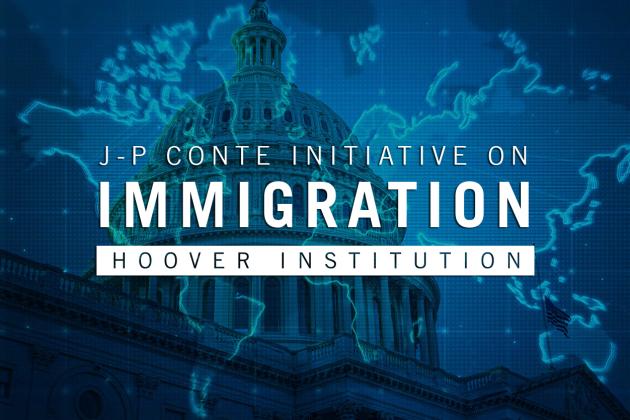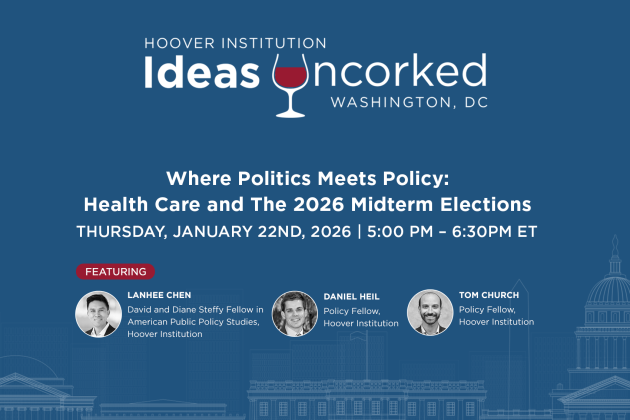PARTICIPANTS
Doug Holtz-Eakin, Scott Atlas, Adrien Auclert, Michael Bordo, Michael Boskin, David Brady, Kate Bundorf, John Cochrane, Tom Gilligan, Bob Hall, Rick Hanushek, Laurie Hodrick, Bob Hodrick, Nick Hope, Oleg Itskhoki, Ken Judd, Dan Kessler, Lance Lochner, Lee Lockwood, David Mulford, Michael Nordeen, Paul Peterson, Josh Rauh, Greg Rosston, Gopi Shah Goda, George Shultz, Richard Sousa, John Taylor, Kevin Warsh, Sean Xu.
ISSUES DISCUSSED
Doug Holtz-Eakin, President of the American Action Forum, presented a "Policy Analysis in the Trump Policy Agenda.” Doug Holtz-Eakin first gave a rundown of the current situation in Washington, then moved to issues where outside thinking could help.
In Holtz-Eakin’s view, not much will happen this year. Congress is currently fighting over continuing current spending levels, even though nobody thinks this is the right outcome. Everyone recognizes we need more defense spending. The just released defense strategy, allows budgets to be forward-looking, so strategy drives budgets not vice versa. Comparable adjustments are needed to non-defense requests. CHIP needs reauthorization, flood insurance is a disaster needing reform, and we need to resolve DACA. It’s not getting done.
No one is dealing with the structural problem. The reason we have spending caps is the failure to come to terms with long-term deficits — entitlements and mandatory spending. Caps are divorced from policy reality, and thus fail. No one is making a compelling argument that debt and deficits needs attention. We are sailing into a sovereign debt crisis, and that is not a strategy.
Holtz-Eakin led a detailed discussion on the Congressional Budget Office (CBO) and its role. The CBO scoring of health reform is a classic example. The CBO said millions would lose health insurance if the mandate were removed, causing a firestorm and the eventual failure of the health bill. The same outrageously large estimate then allowed the tax bill to claim great savings from removing the mandate. How did this happen?
He started with some background. Scoring is not the same as forecasting or economic analysis. The point of scoring is to analyze effect of legislation on revenues and spending. By law, the CBO forms a baseline forecast of what happens under current law. This is not the same as an economic forecast which would incorporate likely changes to the law, for example, promises to cut doctor reimbursements or reauthorize certain programs. Then, the CBO does not change the baseline through the year, even as events change. The point is to rank different options of the same legislation, not to form a forecast.
So, what happened? In 2016, the congress passed the 2017 budget resolution with amazing speed, to get the reconciliation process going so they could pass legislation including health care with just Republican votes. But at that point the CBO baseline was not done. The budget committees directed the CBO to use the previous year, 2016, baseline, to score and therefore rank legislation.
Here was the key. In 2016, the CBO was forecasting that 18 million people would sign up for health insurance, in part due to the force of the mandate. In fact, only 10 million people signed up. So any legislation involving health care—the discussion suggested a bill saying “mom and apple pie are good for health care”—would have been scored as saying 8 million people would “lose” health insurance. Craftily, that means that any bill would score as saving 8 million people’s worth of exchange and Medicare subsidies too.
Beyond the 8 million mistaken forecast for 2016, the 2016 baseline also forecast 5 more million would sign up in following years, though there was no evidence on the ground.
What to do about it? Holtz-Eakin suggested several times that it would be good to have competition on baseline scenario. Private forecasters and others should examine the CBO’s work and provide alternative views.
Cochrane asked about CBO transparency. The CBO does not publish its models, and you can’t replicate their numbers. A more public and transparent process would help this competition a lot. Hall, who meets with the CBO and reviews its forecasts, pointed out that there is feedback from real world forecasters through this process. He also pointed out that typically averaging lots of models works better than perfecting a single complex model. Taylor questioned the CBO’s procedure of splicing together a “short run” business cycle demand model with a long run projection.
Holtz-Eakin explained that the CBO health staff really thinks the mandate causes people to buy health insurance. They have a regulatory mindset, not an incentives mindset. If the law says you should buy health insurance, they assume that people do so. This drove the scoring. When in the tax bill, dropping the mandate was the only change to the ACA, the CBO said this would cause 7 million people to drop subsidized insurance, and 5 million to not bother to sign up for free Medicaid. To their credit, the CBO did not change this assumption once made, so bills were consistently scored—as, recall, is the purpose of scoring. And when congressional republicans used the obviously false assumption for tax scoring purposes, they didn’t change it.
Shultz asked, why not go back to the old-fashioned way? The President carefully prepares a budget. The CEA, Treasury, and OMB make an economic forecast, and thus a revenue forecast. Then departments submit spending requests. The administration submits to Congress, there is testimony of all the components and from each department. Appropriations are known at the beginning of year, and heads can manage their departments. Now, we have continuing resolutions, the sequester which stupidly cuts everything by the same amount. The result is a picture of stupidity and incompetence.
Holtz-Eakin answered, “What happened?” It has been a long time since a Presidents’ budget was not dead on arrival in Congress. For example, Obama did submit budgets, which Congress simply ignored.
Boskin opined that now that half or less of voters pay any taxes, and the majority of voters receive benefits, the parties have realigned. There is more support for transfers, and less objections to taxes.
Holtz-Eakin continued that the central problem is that coverage numbers, and behavioral responses to health insurance schemes, are really not the CBO’s job. The CBO is set up to add up, if the Congress appropriates x money, or gives x money to people in y category, how much does it cost. Figuring out how people respond to an incentive is really not the sort of thing the CBO is set up to do. Block grants are much simpler.
Kessler said, “Ok, it was hard and maybe not the CBOs fault, but the result was a disaster.” It was read as the official government forecast of what’s going to happen. He echoed the feeling that there is a beast to score command and control interventions vs. market-oriented incentives. The mandate is a perfect example. He asked if there is any way to improve the CBO’s handling of incentives.
Holtz-Eakin made several points: 1) The decisions the CBO has reached about responses to mandate and other responses could be improved. He was frustrated by the lack of economic analysis from the CBO health team. They really don’t believe in incentives, they believe in regulations. He explained from his time at CBO that medicate modernization was based on bidding by private entities which they couldn’t handle and thought the bidding would fail, which it never did. His solution was to put a labor economist in charge of the health part. 2) The CBO is supposed to use the consensus in literature, which raises a second set of issues. 3) He reiterated that it would be better to have competition, based on transparent analysis, of the CBO’s baseline and scoring. 4) The rules. The CBO works within rules set by congress. The idea of the baseline is crazy, really. Brady pointed out that changing rules is dangerous as the next party is likely to change them quickly. General consensus is that changing rules has to be bipartisan and not much is bipartisan these days.
Taylor noted that there is a project at Hoover to evaluate monetary policies with different models. Could we do that for budget impacts?
Holtz-Eakin opined that at CBO the standard should not be complete replicability. 1) There is lots of proprietary data. For example, CBO gets data from drug companies on what drugs are in the pipelines, so they can guess what seniors have to pay. They can’t even share that data with Congress. 2) Scoring is in the end a judgement. Models inform judgement, but it is not a mechanical process. For example, he was asked to score a bill allocating $100,000 for death benefits in the Iraq war, before the war started. To do that one needs a forecast of casualties. He scored the terrorism risk insurance act. These are at best informed guesses not models.
Moreover, judgement integrates across models, and models are all simplified to illustrate specific channels. For example, the Joint Committee on taxation has three different models: a DSGE closed economy heterogenous agents model, a Business cycle mode, and a OLG open economy model. We are at full employment, so the first two make little sense to score a supply-side tax bill with important international components.
Kate Bundorf asked that health is interesting as there has been a lot of model competition. But the competitor forecasts are not transparent either, so there is a lot of fighting over numbers, and nobody really knows why the numbers are different. If there is going to be competition, it must come with transparent models!
David Mulford brought us back to the debt question. The debt is skyrocketing, and we are on the path to a debt crisis. What to do?
Bob Hall pointed out that the US historically had a stable fiscal policy. In good times debt/GDP falls, in bad times it rises. In 2001 that pattern changed and debt just rised. However, he noted many economists object — the interest rate seems stuck lower than the growth rate, so government debt in essence never has to be paid back. We seem to be in the r<g regime. The deficit is vastly higher than it’s ever been. We’re borrowing at the same rate as in the trough of a terrible recession. He warned that if rates go back to normal, we will have a complete collapse of federal, state, and local government, essentially a run on sovereign debt.
Holtz-Eakin said the tax bill will soon lead us to trillion dollar annual deficits. The original sin is entitlements and mandatory spending. For two hundred years the US kept a sound fiscal policy because expenditures were annually appropriated.
Mike Boskin asked the Japan question. Debt is 200% of GDP and nothing happens for decades. Shultz quickly pointed out their debt is held by Japanese people not foreign central banks. And Japan is vulnerable too.
Mike Bordo opined that things aren’t so dire. In the US we have historically reformed before crises came. There is fiscal space—we could raise taxes, by a VAT if needed, and easily pay for entitlements. (Boskin quickly pointed out that would lower growth). He pointed to the recent Canadian reform. A deal will happen.
Hotlz-Eakin responded that we are part of that painful reform process. It’s not automatic. Moreover, it’s imperative to do it quickly. If we wait until bond markets say no, we will have to raise taxes sharply at just the wrong time, in a recession and financial crisis.
Warsh opined that there is nothing natural about rates. Negative issuance of debt all bought by central banks. (Hall and Cochrane quickly disagreed). He believes QE is lowering rates, along with financial repression, and buyers indifferent to prices. He noted that if interest rates go to 5.4% then rolling over the debt implies $2.6 Trillion extra deficits. All quickly agreed that whether or not the Fed is currently holding down rates, we are in the classic multiple - equilibrium debt-crisis scenario that the debt is sustainable at low interest rates, but should rates jump just to historic norms like 5%, we would quickly face a spiral, along with spiraling state and local governments and pensions which the Federal Government could not bail out. Warsh was also skeptical of competition. He noted that all sorts of forecasters competing with Fed dots, but it turns out the private forecasts are pretty much identical to each other and identical with the Fed’s. And the Fed is completely transparent, having posted the code of its model to its website. Private forecasters don’t want to be too far off of the Fed, and Fed forecasts have crowded out independent judgements. And all are wrong together.
-John Cochrane









